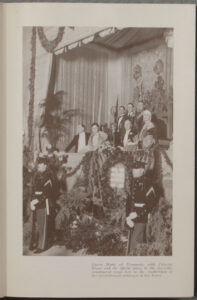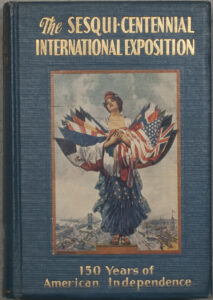85 years before MIT’s sesquicentennial, the United States celebrated a 150th birthday of its own. The Sesqui-Centennial International Exhibition was held in Philadelphia from May 31 through November 30, 1926 to commemorate the 150th anniversary of the signing of the Declaration of Independence. As the introduction to this text breathlessly declares, the fair “invited the American people to assemble at the most sacred spot on the American continent; upon the most important date in the entire history of political liberty; and to commemorate an event farther reaching in its effect than any which has transpired since the beginning of the Christian era.”
 During the 6 months the fair was open, nearly 6.5 million people accepted that invitation. They passed underneath an 80-foot-tall replica of the Liberty Bell (illuminated with 26,000 bulbs) to enter through the Exhibition gates. Once inside, they enjoyed exhibits in the various exhibition palaces and state and country buildings; they watched shows, strolled down a recreated 1776 Philadelphia “High Street,” and participated in special days and celebrations. Attendees witnessed demonstrations of such “modern wonders of applied science” as the radio, electrical refrigeration, “talking” motion pictures, and “labor-saving devices for the home and for business.”
During the 6 months the fair was open, nearly 6.5 million people accepted that invitation. They passed underneath an 80-foot-tall replica of the Liberty Bell (illuminated with 26,000 bulbs) to enter through the Exhibition gates. Once inside, they enjoyed exhibits in the various exhibition palaces and state and country buildings; they watched shows, strolled down a recreated 1776 Philadelphia “High Street,” and participated in special days and celebrations. Attendees witnessed demonstrations of such “modern wonders of applied science” as the radio, electrical refrigeration, “talking” motion pictures, and “labor-saving devices for the home and for business.”
This volume, published 3 years later, details in 35 enthusiastic chapters (plus appendices) every aspect of the Exposition from “Early History of the Project” in Chapter II all the way through “Dog Show, Poultry, Pigeon and Pet Stock Shows” in Chapter XXXV.
A chapter devoted to the celebration of 122 “Special Days”  describes several of them, but leaves the reader wondering what might have transpired during the festivities associated with “Librarian Day” (August 24) and “National Puzzlers’ Day” (September 4).
describes several of them, but leaves the reader wondering what might have transpired during the festivities associated with “Librarian Day” (August 24) and “National Puzzlers’ Day” (September 4).
The numerous sepia-toned photos in the book offer a glimpse into the Exhibition’s buildings, events, and displays. In so doing they help fulfill the volume’s stated goal of making the “events of the year 1776 live again within the pages of a book, as the Exposition sought to make them live again in its patriotic observances, its architectural design with the Forum of the Founders and the columns of the signers, and its High Street of ’76.”

